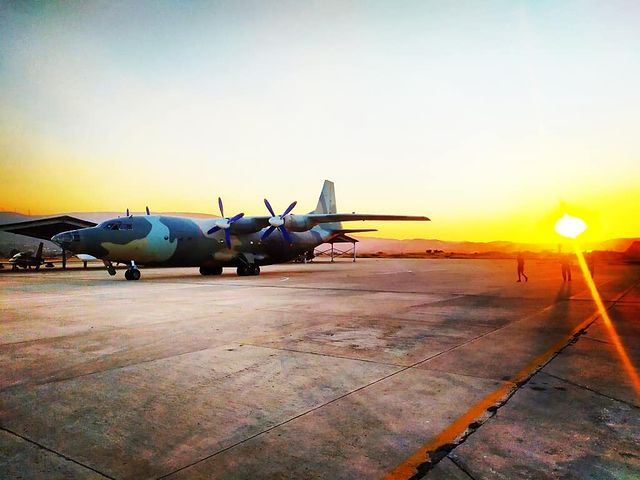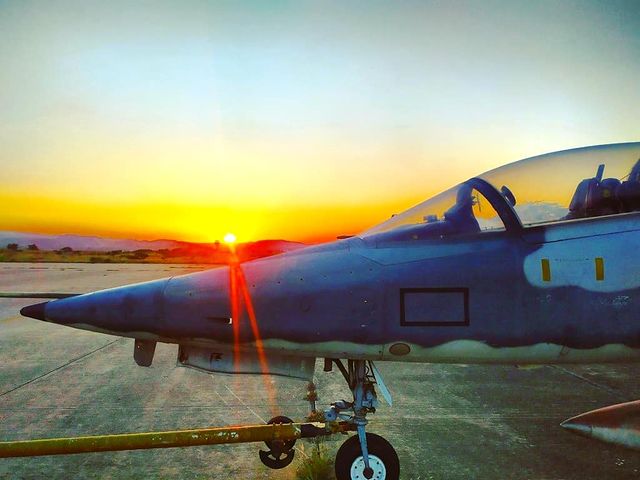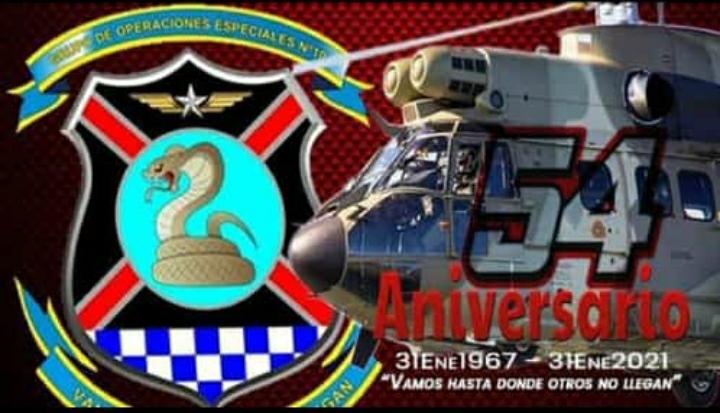
Aviación Militar Bolivariana de Venezuela - AMBV
-
JRAP2020
- Teniente Coronel

- Mensajes: 2344
- Registrado: 30 Ene 2021, 20:56

Aviación Militar Bolivariana de Venezuela
54 aniversario del Grupo Aéreo de Operaciones Especiales N°10 "Cobras". Créditos FAV


-
JRAP2020
- Teniente Coronel

- Mensajes: 2344
- Registrado: 30 Ene 2021, 20:56

Aviación Militar Bolivariana de Venezuela
Primer Teniente Mariana Aguilar se ha certificado como Instructora en sistema T-27 Tucano del Grupo de Entrenamiento Aéreo Nº14 "Escorpiones". Créditos FAV


-
REDSTARSKI
- General de Brigada

- Mensajes: 5249
- Registrado: 31 Ene 2020, 00:45

Aviación Militar Bolivariana de Venezuela
Quiero pedir disculpas por haber dudado de la revolucion bolivariana, efectivamente parece que los iraníes tuvieron que ver con lo que llamanla reparación del C 130.REDSTARSKI escribió: ↑31 Ene 2021, 19:48 Iranies reparando un C130 en Venezuela,............... Suena un poquitin mojoneado por lo del Mojan.
si eso implico hombres persas echándole llave al c130 o solamente un ingeniero señalando suelte aquí o apriete ahí, no se sabe.
https://es.wikipedia.org/wiki/Accidente ... AD_en_2005
Este accidente fue el desastre de aviación más mortífero en Irán desde febrero de 2003, cuando 275 personas murieron cuando un avión de transporte militar se estrelló en el sur de Irán.8 Debido a las sanciones de Estados Unidos, Irán no ha podido comprar nuevos aviones occidentales (ya sean comerciales o militares) o repuestos para aviones existentes de fabricantes estadounidenses.9 Los aviones militares de fabricación estadounidense que ahora operan en Irán fueron comprados bajo el antiguo régimen durante la década de 1970. Los funcionarios iraníes culparon a las sanciones del pobre historial de aviación del país.10
Afortunadamente nadie murió en este guiso, entregar un activo de la nacion a gente sin credenciales en la materia.
Esta situación es nueva de ahí que resultase difícil hacer predicciones. 
-
Edux
- Recluta

- Mensajes: 5
- Registrado: 06 Jul 2007, 11:49

Aviación Militar Bolivariana de Venezuela
Un saludo cordial a todos los foristas
Este es mi primer post en este foro y espero que sea de utilidad en esta comunidad.
Quisiera compartir con todos el siguiente articulo que ha sido publicado por la revista Military Watch Magazine sobre las que ellos evalúan como las cinco mejores FFAA de latinoamérica.
El texto esta en ingles y para no hacer un mensaje muy largo no lo he traducido, espero que no sea esto una falta en el foro.
Top Five Air Forces in Latin America: From Venezuela and Cuba to Chile and Peru (January-25th-2021)
In terms of the potency of its collective aerial warfare capabilities, South America is very likely the least capable of the world's six inhabited continents. Even remotely modern combat jet aircraft are relatively few and far between, which can partly be attributed to the hegemony of the United States over the region meaning most countries can afford to neglect investment in a modern air force. There have been some exceptions, including Chile which has maintained a relatively capable fleet considering the size of its small economy, Venezuela which under the Hugo Chavez administration use its oil book to acquire the region’s only heavyweight combat jets, and formerly Cuba which boasted by far the most capable combat fleet in the Latin world during the Cold War. A look at the five most capable air forces in Latin America in terms of combat capabilities is given below.
Venezuela
Venezuela’s Air Force fields the most capable fleet of combat aircraft in Latin America by a considerable margin, with its backbone formed of 23 Su-30MK2 heavyweight fighters acquired from Russia. These are among the best equipped in the region, and have the highest ranges and weapons payloads, the most powerful sensor suites and the best flight performances. The fighters are equipped with R-77 active radar guided long range air to air missile as well as longer ranged R-27ER missiles and Kh-31 cruise missiles, and are unrivalled by any aircraft in the Americas outside the United States Military. Venezuela also deploys two small squadrons of F-16A Fighting Falcons - some of the least capable variants of the F-16 in service anywhere in the world which have no beyond visual range air to air missiles whatsoever. By comparison to other fighters deployed in South America, these F-16s still have an above average combat potential. Venezuela also deploys what is by far the region’s most capable ground based air defence network, which is based around the BuK-M2 medium range surface to air missile system and the S-300VM - the second most capable S-300 variant ever developed which has a formidable 250km engagement range and can engage targets at high Mach 14 speeds.
Chile
Chile has long fielded a highly capable Air Force which is known for its high training standards relative to other regional powers, and for having embarrassed the U.S. Navy during mock combat exercises by winning against it. The backbone of the fleet is comprised of ageing F-16A fighters, with 36 F-16A/B jets in service. The newer F-16C Block 50 forms the elite of the fleet with ten of these in service in service. What is notable about the Chilean fleet is that it is one of just three in the region with modern long range air to air missiles - and the only country with non-Russian aircraft the integrate such missiles. The AIM-120C active radar guided long range missile has a similar performance to the Russian R-77 used by Venezuela and Peru, and make its F-16s far more capable than any other Western made aircraft in the region. Chile also deploys one of the region’s few airborne early warning aircraft with a single Boeing-707 equipped with an Israeli Phalcon radar - a major force multiplier. The country also has one of the region’s most formidable fleets of aerial refuelling aircraft with 3 KC-135 Stratotankers. These compensate for the F-16’s relatively short range and allow them to operate beyond the country’s borders for extended periods. These assets are supplemented by a squadron of older third generation F-5E Tiger II lightweight fighters.
Peru
Peru is one of just two countries in South America with a fighter fleet comprised entirely of fourth generation aircraft alongside Venezuela, with its Air Force’s elite comprised of a squadron of 19 MiG-29 fighters of mid-range S and SMP variants. These are equipped with modern avionics and both R-77 and R-27 air to air missiles making them highly formidable in an air defence role. The MiG-29 is one of the most manoeuvrable fighters ever designed, and when equipped with a modern radar and the R-77 it becomes almost as dangerous at long ranges as it is at short ones. The country also deploys a squadron of 12 Mirage 2000 lightweight fighters, although these are not equipped with any modern air to air missiles meaning they form perhaps the weakest Mirage 2000 unit in the world. For a ground attack role Peru also deploys 18 Russian Su-25 jets.
Cuba
Formerly fielding by far the most capable Air Force in the region, in terms of the numbers of fighter aircraft deployed Cuba still has the largest combat fleet in Latin America by a considerable margin. It is hampered however by a lack of large numbers of post-third generation aircraft and by low combat readiness rates, with the loss of Soviet support after the superpower’s collapse in 1991 meaning that it can no longer service the full fleet and that deliveries of modern MiG-29 jets had to be halted. The Cuban Air Force is the only one in the region with significant experience in air to air combat including in using beyond visual range air to air missiles, and was the most competent operator of the MiG-23 swept wing fighter to have used it in combat when it took on the Mirage F1 jets of the South African Air Force and came out ahead. Cuba’s fleet is unlikely to recover without either further aid or drastic improvement to its economy, but by regional standards it is still one of the most capable today. The MiG-29 forms the elite of the Cuban fleet with just seven of them in service, while the bulk of the country’s combat potential is formed of approximately 60 enhanced third generation MiG-23 fighters. Although requiring high maintenance, these have comparable sensors to the early fourth generation F-16A and field beyond visual range air to air missiles - an asset few fighter units in the region have. Approximately 180 enhanced third generation MiG-21 fighters are also in service although the bulk of these have been placed in storage.
Brazil
The Brazilian Air Force is by far the weakest service in the country’s armed forces, and although relatively large with 46 fighters in service their capabilities leave much to be desired even by regional standards. The entire fleet is comprised of light third generation F-5E Tiger II jets, and although these have been upgraded with relatively modern electronic warfare systems they lack any form of beyond visual range air to air capabilities. This means Brazil’s top fighter would face a serious disadvantage against even Cuba’s MiG-23 or Venezuela’s F-16A, let alone more advanced aircraft such as the Chilean F-16C or Peruvian MiG-29. The issue of a lack of beyond visual range missiles is compounded by the country’s total lack of ground based air defences beyond small shoulder fired MANPADS, meaning Brazil’s airspace is perhaps the easiest to penetrate of any large country. Although the country does field a sizeable fleet of airborne early warning aircraft, these are considerably less sophisticated than most designs such as the Chilean 707 Phalcon and have weaker radars, while the total lack of long range anti aircraft capabilities in the country means these 'flying radars' will be essentially defenceless.
Este es mi primer post en este foro y espero que sea de utilidad en esta comunidad.
Quisiera compartir con todos el siguiente articulo que ha sido publicado por la revista Military Watch Magazine sobre las que ellos evalúan como las cinco mejores FFAA de latinoamérica.
El texto esta en ingles y para no hacer un mensaje muy largo no lo he traducido, espero que no sea esto una falta en el foro.
Top Five Air Forces in Latin America: From Venezuela and Cuba to Chile and Peru (January-25th-2021)
In terms of the potency of its collective aerial warfare capabilities, South America is very likely the least capable of the world's six inhabited continents. Even remotely modern combat jet aircraft are relatively few and far between, which can partly be attributed to the hegemony of the United States over the region meaning most countries can afford to neglect investment in a modern air force. There have been some exceptions, including Chile which has maintained a relatively capable fleet considering the size of its small economy, Venezuela which under the Hugo Chavez administration use its oil book to acquire the region’s only heavyweight combat jets, and formerly Cuba which boasted by far the most capable combat fleet in the Latin world during the Cold War. A look at the five most capable air forces in Latin America in terms of combat capabilities is given below.
Venezuela
Venezuela’s Air Force fields the most capable fleet of combat aircraft in Latin America by a considerable margin, with its backbone formed of 23 Su-30MK2 heavyweight fighters acquired from Russia. These are among the best equipped in the region, and have the highest ranges and weapons payloads, the most powerful sensor suites and the best flight performances. The fighters are equipped with R-77 active radar guided long range air to air missile as well as longer ranged R-27ER missiles and Kh-31 cruise missiles, and are unrivalled by any aircraft in the Americas outside the United States Military. Venezuela also deploys two small squadrons of F-16A Fighting Falcons - some of the least capable variants of the F-16 in service anywhere in the world which have no beyond visual range air to air missiles whatsoever. By comparison to other fighters deployed in South America, these F-16s still have an above average combat potential. Venezuela also deploys what is by far the region’s most capable ground based air defence network, which is based around the BuK-M2 medium range surface to air missile system and the S-300VM - the second most capable S-300 variant ever developed which has a formidable 250km engagement range and can engage targets at high Mach 14 speeds.
Chile
Chile has long fielded a highly capable Air Force which is known for its high training standards relative to other regional powers, and for having embarrassed the U.S. Navy during mock combat exercises by winning against it. The backbone of the fleet is comprised of ageing F-16A fighters, with 36 F-16A/B jets in service. The newer F-16C Block 50 forms the elite of the fleet with ten of these in service in service. What is notable about the Chilean fleet is that it is one of just three in the region with modern long range air to air missiles - and the only country with non-Russian aircraft the integrate such missiles. The AIM-120C active radar guided long range missile has a similar performance to the Russian R-77 used by Venezuela and Peru, and make its F-16s far more capable than any other Western made aircraft in the region. Chile also deploys one of the region’s few airborne early warning aircraft with a single Boeing-707 equipped with an Israeli Phalcon radar - a major force multiplier. The country also has one of the region’s most formidable fleets of aerial refuelling aircraft with 3 KC-135 Stratotankers. These compensate for the F-16’s relatively short range and allow them to operate beyond the country’s borders for extended periods. These assets are supplemented by a squadron of older third generation F-5E Tiger II lightweight fighters.
Peru
Peru is one of just two countries in South America with a fighter fleet comprised entirely of fourth generation aircraft alongside Venezuela, with its Air Force’s elite comprised of a squadron of 19 MiG-29 fighters of mid-range S and SMP variants. These are equipped with modern avionics and both R-77 and R-27 air to air missiles making them highly formidable in an air defence role. The MiG-29 is one of the most manoeuvrable fighters ever designed, and when equipped with a modern radar and the R-77 it becomes almost as dangerous at long ranges as it is at short ones. The country also deploys a squadron of 12 Mirage 2000 lightweight fighters, although these are not equipped with any modern air to air missiles meaning they form perhaps the weakest Mirage 2000 unit in the world. For a ground attack role Peru also deploys 18 Russian Su-25 jets.
Cuba
Formerly fielding by far the most capable Air Force in the region, in terms of the numbers of fighter aircraft deployed Cuba still has the largest combat fleet in Latin America by a considerable margin. It is hampered however by a lack of large numbers of post-third generation aircraft and by low combat readiness rates, with the loss of Soviet support after the superpower’s collapse in 1991 meaning that it can no longer service the full fleet and that deliveries of modern MiG-29 jets had to be halted. The Cuban Air Force is the only one in the region with significant experience in air to air combat including in using beyond visual range air to air missiles, and was the most competent operator of the MiG-23 swept wing fighter to have used it in combat when it took on the Mirage F1 jets of the South African Air Force and came out ahead. Cuba’s fleet is unlikely to recover without either further aid or drastic improvement to its economy, but by regional standards it is still one of the most capable today. The MiG-29 forms the elite of the Cuban fleet with just seven of them in service, while the bulk of the country’s combat potential is formed of approximately 60 enhanced third generation MiG-23 fighters. Although requiring high maintenance, these have comparable sensors to the early fourth generation F-16A and field beyond visual range air to air missiles - an asset few fighter units in the region have. Approximately 180 enhanced third generation MiG-21 fighters are also in service although the bulk of these have been placed in storage.
Brazil
The Brazilian Air Force is by far the weakest service in the country’s armed forces, and although relatively large with 46 fighters in service their capabilities leave much to be desired even by regional standards. The entire fleet is comprised of light third generation F-5E Tiger II jets, and although these have been upgraded with relatively modern electronic warfare systems they lack any form of beyond visual range air to air capabilities. This means Brazil’s top fighter would face a serious disadvantage against even Cuba’s MiG-23 or Venezuela’s F-16A, let alone more advanced aircraft such as the Chilean F-16C or Peruvian MiG-29. The issue of a lack of beyond visual range missiles is compounded by the country’s total lack of ground based air defences beyond small shoulder fired MANPADS, meaning Brazil’s airspace is perhaps the easiest to penetrate of any large country. Although the country does field a sizeable fleet of airborne early warning aircraft, these are considerably less sophisticated than most designs such as the Chilean 707 Phalcon and have weaker radars, while the total lack of long range anti aircraft capabilities in the country means these 'flying radars' will be essentially defenceless.
- Anderson
- General de Cuerpo de Ejército

- Mensajes: 9981
- Registrado: 09 May 2008, 02:46
- Ubicación: Medellín

Aviación Militar Bolivariana de Venezuela
¿Y dónde me dejan a mi amada FAC llena de aviones de enlace y transporte VIP? 
Tierra de héroes anónimos y espíritus libres...
-
REDSTARSKI
- General de Brigada

- Mensajes: 5249
- Registrado: 31 Ene 2020, 00:45

Aviación Militar Bolivariana de Venezuela
Esos en la otra lista de primeros, la de los militares que mejor saben vivir. 
Esta situación es nueva de ahí que resultase difícil hacer predicciones. 
- Andrés Eduardo González
- General

- Mensajes: 31473
- Registrado: 05 Jul 2007, 17:33
- Ubicación: Bogotá (Colombia)

Aviación Militar Bolivariana de Venezuela
REDSTARSKI escribió: ↑02 Feb 2021, 12:46 Esos en la otra lista de primeros, la de los militares que mejor saben vivir.
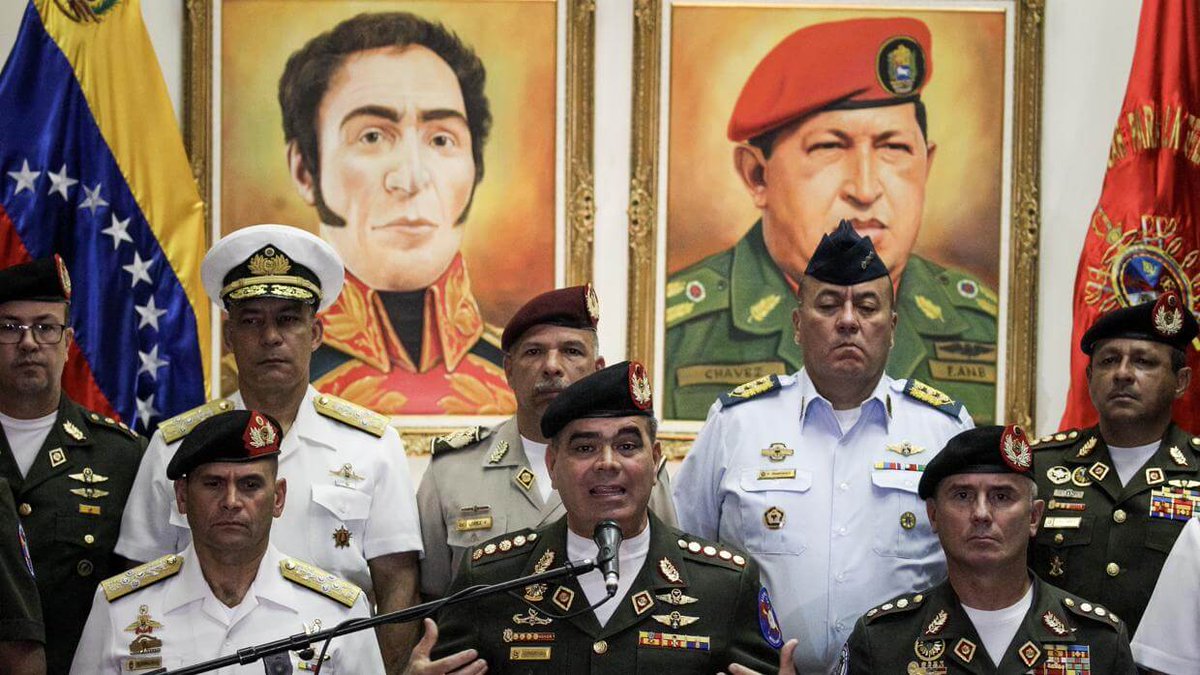
"En momentos de crisis, el pueblo clama a Dios y pide ayuda al soldado. En tiempos de paz, Dios es olvidado y el soldado despreciado».
-
REDSTARSKI
- General de Brigada

- Mensajes: 5249
- Registrado: 31 Ene 2020, 00:45

Aviación Militar Bolivariana de Venezuela
El traidor nunca vive feliz.
Esta situación es nueva de ahí que resultase difícil hacer predicciones. 
- SAETA2003
- General de Cuerpo de Ejército

- Mensajes: 8874
- Registrado: 10 Ago 2009, 19:56

Aviación Militar Bolivariana de Venezuela
Servicio de transporte de la AMV hace entrega del primer lote de vehículos oficiales recuperados.
https://twitter.com/Dir_Logisti_AMB/sta ... 14176?s=20
https://twitter.com/Dir_Logisti_AMB/sta ... 14176?s=20
Si Vis Pacem, Para Bellum
- SAETA2003
- General de Cuerpo de Ejército

- Mensajes: 8874
- Registrado: 10 Ago 2009, 19:56

- SAETA2003
- General de Cuerpo de Ejército

- Mensajes: 8874
- Registrado: 10 Ago 2009, 19:56

Aviación Militar Bolivariana de Venezuela
Venezuela revela en un vídeo el verdadero estado de su flota de cazas F-16
12:17 GMT 01.02.2021(actualizada a las 23:28 GMT 01.02.2021)
Con los rumores sobre la supuesta entrega de sus cazas F-16 a Irán o Rusia de fondo, la Aviación Militar Bolivariana compartió un vídeo para informar sobre el estado de su flota de cazas de este modelo.
El Grupo Aéreo de Caza número 16 informó en su cuenta de Twitter que emplea cazas de fabricación estadounidense y que se encuentra totalmente operativo a pesar de las sanciones, que, dicen, crean muchos problemas a la hora de mantener las aeronaves en buenas condiciones.
#Dato En no pocas ocasiones se han formulado conjeturas infames sobre el destino que le damos a nuestros sistemas de armas. Un ejemplo de ello ha sido el sistema F-16.....
pic.twitter.com/MxiSwfpL1V
— AMB_FANB (@AmbFanb) January 28, 2021
Asimismo, la Aviación Militar Bolivariana destaca que las afirmaciones de algunos medios de comunicación, según las cuales Venezuela ha enviado a Rusia y a Irán dichos cazas, no corresponden con la realidad y que todos los F-16 venezolanos se encuentran en el país caribeño.
Los equipos técnicos venezolanos se encargan de mantener estas aeronaves operativas, pese al embargo tecnológico y armamentístico impuesto por EEUU desde la llegada de Hugo Chávez al poder. Actualmente, la Aviación Militar Bolivariana está compuesta principalmente por los cazas Su-30MK2 de fabricación rusa, que la convierten en una de las Fuerzas Aéreas más fuertes de la región.
Los sistemas de misiles rusos S-300VM y BuK-M2 también ayudan al país caribeño a mantener el control de su espacio aéreo. Sirven para la defensa aérea de largo y medio alcance contra un gran abanico de blancos aéreos.
Fuente:
https://mundo.sputniknews.com/defensa/2 ... azas-f-16/
Si Vis Pacem, Para Bellum
- Andrés Eduardo González
- General

- Mensajes: 31473
- Registrado: 05 Jul 2007, 17:33
- Ubicación: Bogotá (Colombia)

Aviación Militar Bolivariana de Venezuela
"En momentos de crisis, el pueblo clama a Dios y pide ayuda al soldado. En tiempos de paz, Dios es olvidado y el soldado despreciado».
- SAETA2003
- General de Cuerpo de Ejército

- Mensajes: 8874
- Registrado: 10 Ago 2009, 19:56

-
JRAP2020
- Teniente Coronel

- Mensajes: 2344
- Registrado: 30 Ene 2021, 20:56

-
JRAP2020
- Teniente Coronel

- Mensajes: 2344
- Registrado: 30 Ene 2021, 20:56

Aviación Militar Bolivariana de Venezuela
Bonita foto de un par de Dornier Do-228-212NG del Grupo Aéreo de Transporte Nº9 "Tucanes". Créditos Argen Reyes Clavijo
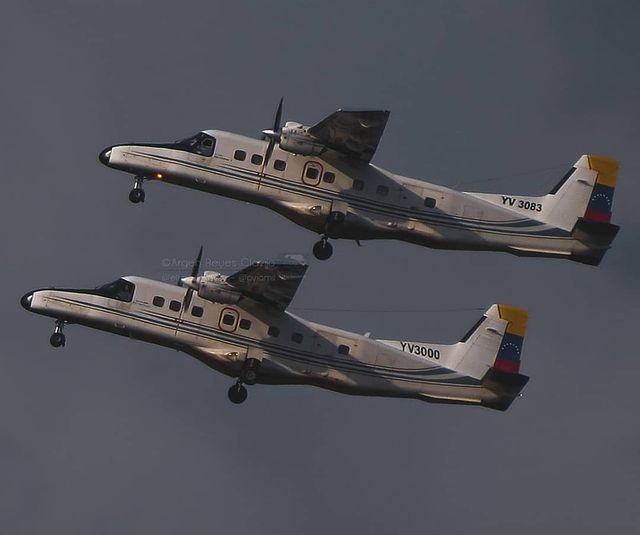

¿Quién está conectado?
Usuarios navegando por este Foro: ClaudeBot [Bot] y 2 invitados



